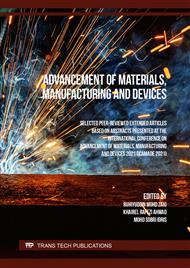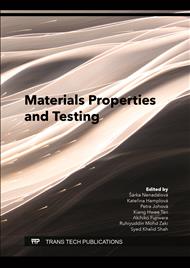[1]
K. Chen, T.P. Pasanen, V. Vähänissi, H. Savin, Effect of MACE Parameters on Electrical and Optical Properties of ALD Passivated Black Silicon, (2019).
DOI: 10.1109/jphotov.2019.2917787
Google Scholar
[2]
Z. Zhao, P. Li, Y. Wei, C. Lu, X. Tan, A. Liu, 17.3% Efficient Black Silicon Solar Cell Without Dielectric Antireflection Coating, Sol. Energy. 110 (2014) 714–719.
DOI: 10.1016/j.solener.2014.10.029
Google Scholar
[3]
F.J. Wendisch, M. Abazari, H. Mahdavi, M. Rey, N. Vogel, M. Musso, O. Diwald, G.R. Bourret, Morphology-Graded Silicon Nanowire Arrays via Chemical Etching: Engineering Optical Properties at the Nanoscale and Macroscale, ACS Appl. Mater. Interfaces. 12 (2020) 13140–13147.
DOI: 10.1021/acsami.9b21466
Google Scholar
[4]
H. Park, M. Ju, M.Q. Khokhar, E.C. Cho, Y. Kim, Y. Cho, J. Yi, Surface Modifications for Light Trapping in Silicon Heterojunction Solar Cells: A Brief Review, Trans. Electr. Electron. Mater. (2020).
DOI: 10.1007/s42341-020-00203-1
Google Scholar
[5]
C.H. Hsu, J.R. Wu, Y.T. Lu, D.J. Flood, A.R. Barron, L.C. Chen, Fabrication and characteristics of black silicon for solar cell applications: An overview, Mater. Sci. Semicond. Process. 25 (2014) 2–17.
DOI: 10.1016/j.mssp.2014.02.005
Google Scholar
[6]
G. Von Gastrow, P. Ortega, R. Alcubilla, S. Husein, T. Nietzold, M. Bertoni, H. Savin, Recombination processes in passivated boron-implanted black silicon emitters, J. Appl. Phys. 121 (2017).
DOI: 10.1063/1.4983297
Google Scholar
[7]
Z. Wang, P. Li, Z. Liu, J. Fan, X. Qian, J. He, S. Peng, D. He, M. Li, P. Gao, Hole selective materials and device structures of heterojunction solar cells: Recent assessment and future trends, APL Mater. 7 (2019).
DOI: 10.1063/1.5121327
Google Scholar
[8]
Y. Da, X. Liu, Y. Xuan, Q. Li, Photon management effects of hybrid nanostructures/microstructures for organic-silicon heterojunction solar cells, Int. J. Energy Res. 42 (2018) 4875–4890.
DOI: 10.1002/er.4249
Google Scholar
[9]
Z. Liang, M. Su, H. Wang, Y. Gong, F. Xie, L. Gong, H. Meng, P. Liu, H. Chen, W. Xie, J. Chen, Characteristics of a Silicon Nanowires/PEDOT:PSS Heterojunction and Its Effect on the Solar Cell Performance, ACS Appl. Mater. Interfaces. 7 (2015) 5830–5836.
DOI: 10.1021/am508879b
Google Scholar
[10]
W. Kern, The Evolution of Silicon Wafer Cleaning Technology, J. Electrochem. Soc. 137 (1990) 1887.
Google Scholar
[11]
A. Abdulkadir, A.A. Aziz, M.Z. Pakhuruddin, Impact of micro-texturization on hybrid micro/nano-textured surface for enhanced broadband light absorption in crystalline silicon for application in photovoltaics, Mater. Sci. Semicond. Process. 105 (2020) 104728.
DOI: 10.1016/j.mssp.2019.104728
Google Scholar
[12]
A. Abdulkadir, A.A. Aziz, M.Z. Pakhuruddin, Optimization of etching time for broadband absorption enhancement in black silicon fabricated by one-step electroless silver-assisted wet chemical etching, Opt. - Int. J. Light Electron Opt. 187 (2019) 74–80.
DOI: 10.1016/j.ijleo.2019.05.019
Google Scholar
[13]
H. Mehmood, G. Bektaş, İ. Yıldız, T. Tauqeer, H. Nasser, R. Turan, Electrical, optical and surface characterization of reactive RF magnetron sputtered molybdenum oxide films for solar cell applications, Mater. Sci. Semicond. Process. 101 (2019) 46–56.
DOI: 10.1016/j.mssp.2019.05.018
Google Scholar
[14]
A. Abdulkadir, N.A.M. Noor, A.A. Aziz, M.Z. Pakhuruddin, Broadband anti-reflection in black silicon fabricated by two-step silver-assisted wet chemical etching for photovoltaics, in: Solid State Phenom., Trans Tech Publications Ltd, 2020: p.167–174.
DOI: 10.4028/www.scientific.net/ssp.301.167
Google Scholar
[15]
A. Abdulkadir, A.A. Aziz, M.Z. Pakhuruddin, Effects of silver nanoparticles layer thickness towards properties of black silicon fabricated by metal-assisted chemical etching for photovoltaics, SN Appl. Sci. 2 (2020).
DOI: 10.1007/s42452-020-2307-1
Google Scholar
[16]
P. Singh, S.K. Srivastava, M. Yameen, B. Sivaiah, V. Prajapati, P. Prathap, S. Laxmi, B.P. Singh, Vandana, C.M.S. Rauthan, P.K. Singh, Fabrication of vertical silicon nanowire arrays on three-dimensional micro-pyramid-based silicon substrate, J. Mater. Sci. 50 (2015) 6631–6641.
DOI: 10.1007/s10853-015-9210-y
Google Scholar
[17]
C.H. Hsu, S.M. Liu, W.Y. Wu, Y.S. Cho, P.H. Huang, C.J. Huang, S.Y. Lien, W.Z. Zhu, Nanostructured pyramidal black silicon with ultra-low reflectance and high passivation, Arab. J. Chem. (2020).
DOI: 10.1016/j.arabjc.2020.01.004
Google Scholar
[18]
X. Jia, C. Zhou, W. Wang, Optimization of the Surface Structure on Black Silicon for Surface Passivation, Nanoscale Res. Lett. 12 (2017) 0–6.
DOI: 10.1186/s11671-017-1910-6
Google Scholar
[19]
Y. Jiang, X. Gong, R. Qin, H. Liu, C. Xia, H. Ma, Efficiency Enhancement Mechanism for Poly(3,4-ethylenedioxythiophene):Poly(styrenesulfonate)/Silicon Nanowires Hybrid Solar Cells Using Alkali Treatment, Nanoscale Res. Lett. 11(2016).
DOI: 10.1186/s11671-016-1450-5
Google Scholar
[20]
Y.S. Ahmed, T. Hadjersi, N. Khelifati, A. Manseri, H. Menari, Binary-Structured Si Surface Modification by an Alkaline Treatment: Application to Poly(3,4-Ethylenedioxythiophene)-Poly(Styrene Sulfonate)/Silicon Heterojunction Solar Cells, Silicon. (2020) 2–8.
DOI: 10.1007/s12633-020-00419-z
Google Scholar
[21]
D. Zielke, R. Gogolin, M.U. Halbich, C. Marquardt, W. Lövenich, R. Sauer, J. Schmidt, Large-Area PEDOT:PSS/c-Si Heterojunction Solar Cells With Screen-Printed Metal Contacts, Sol. RRL. 2 (2018) 2–7.
DOI: 10.1002/solr.201700191
Google Scholar
[22]
J.P. Thomas, K.T. Leung, Defect-minimized PEDOT:PSS/planar-si solar cell with very high efficiency, Adv. Funct. Mater. 24 (2014) 4978–4985.
DOI: 10.1002/adfm.201400380
Google Scholar
[23]
S.S. Yoon, D.Y. Khang, High Efficiency (>17%) Si-Organic Hybrid Solar Cells by Simultaneous Structural, Electrical, and Interfacial Engineering via Low-Temperature Processes, Adv. Energy Mater. 8 (2018) 1–8.
DOI: 10.1002/aenm.201702655
Google Scholar
[24]
Z. Yang, Z. Fang, J. Sheng, Z. Ling, Z. Liu, J. Zhu, P. Gao, J. Ye, Optoelectronic Evaluation and Loss Analysis of PEDOT:PSS/Si Hybrid Heterojunction Solar Cells, Nanoscale Res. Lett. 12 (2017) 10–15.
DOI: 10.1186/s11671-016-1790-1
Google Scholar
[25]
X. Yu, X. Shen, X. Mu, J. Zhang, B. Sun, L. Zeng, L. Yang, Y. Wu, H. He, D. Yang, High Efficiency Organic/Silicon-Nanowire Hybrid Solar Cells: Significance of Strong Inversion Layer, Sci. Rep. 5 (2015) 1–10.
DOI: 10.1038/srep17371
Google Scholar
[26]
M. Javadi, A. Mazaheri, H. Torbatiyan, Y. Abdi, Mechanism of Charge Transport in Hybrid Organic-Inorganic PEDOT:PSS/Silicon Heterojunctions, Phys. Rev. Appl. 12 (2019) 1–8.
DOI: 10.1103/physrevapplied.12.034002
Google Scholar



